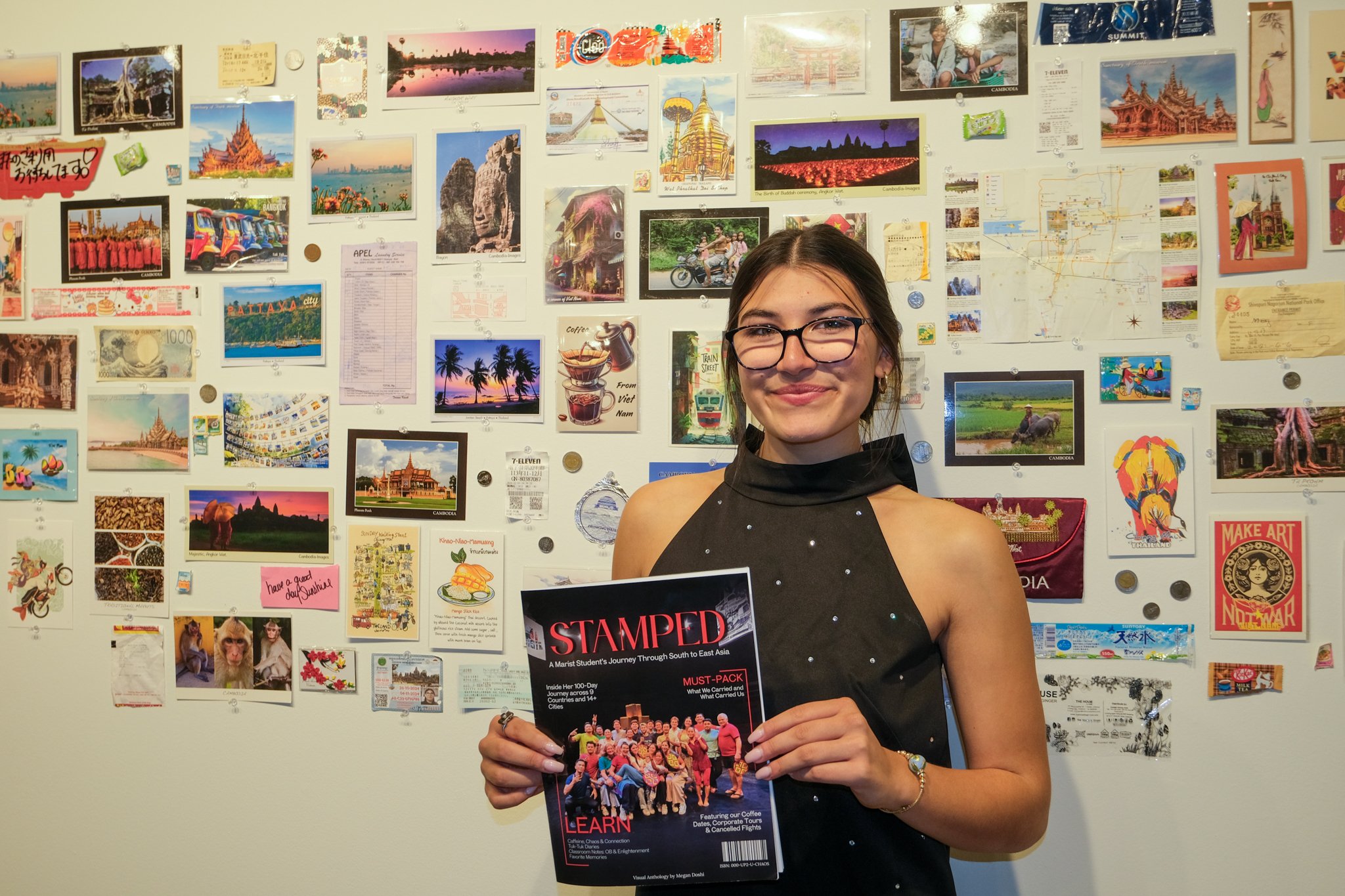STAMPED: A Journey Through Asia
Megan Doshi '26 standing in front of her collage wall with the magazine she created to go along with her exhibit at Steel Plant, STAMPED: A Journey Through Asia. Photo by Ava Battinelli '26
The Steel Plant’s latest gallery marked a new feat: the first exhibit that displays the work of a single student. From Nov. 5 to Nov. 25. STAMPED: A Journey Through Asia displays an exploration through Megan Doshi’s ‘26 experience with the Asia Study Abroad Program (ASAP).
This exhibit tells the story of Doshi’s semester-long travels through nine Asian countries. With the help of Professor of Art and Gallery Director Ed Smith, the Business Administration major filled the space with photographs, souvenirs and memories of her travels, in an effort to share her experience with the Marist University community.
“I just felt that what I was able to take away is so prominent in my life and so transformational,” she said. “I wanted to be able to bring that and put on an exhibit that fosters culture, community and connection, and I was able to share that through many different attributes, which Ed Smith has given me the amazing opportunity of doing.”
Photographs line the walls of the gallery, and a collage of small tickets, postcards and other flat memorabilia is displayed in the exhibit. A video is projected on the back wall of the gallery showing different experiences that ASAPers had while abroad. The middle of the exhibit hosts a glass case of many trinkets, pieces of art and small items that Doshi collected throughout her travels, ranging from larger meaningful objects such as a mandala by a world-renowned Nepalese artist, Madhu Krishna Chitrakar, to smaller objects like bottle caps and pennies flattened on train street in Vietnam.
Doshi took off for Asia during the fall semester of her junior year. Doshi, along with the 19 other students studying abroad through the ASAP program, spent over 100 days traveling to different countries and cities, learning about international business and immersing herself in the Asain culture.
“With the Marist philanthropy of being an ‘and not or’ student, I wanted to continue building my portfolio and how I would leave my legacy,” she said. “I wanted to make my mark on Marist, and that's what the name is behind Stamped, how, as you go through different countries and as you go through different life, you get your mark on different spots.”
The inspiration for the gallery came from a course she took while in Asia: Organizational Behavior with Dr. Wesley King. This sparked Doshi to start researching behavior and experiences such as conducting independent research last semester about her time abroad. That project taught her the power of connecting disciplines and honoring personal history through creative expression. Echoing a similar sentiment was the set of questions that Doshi asked herself before and after studying abroad and comparing the answers.
“And the course itself, I knew I was going to take, but I didn't know that I was going to apply all of that,” she said. “But I did know I wanted to understand myself on a deeper level.”
Arguably, the biggest impact this exhibit has on the Marist community is that it acts as an example of how students can and should do work in different disciplines.
“I don't think majors are dedicated to certain buildings. I shouldn't be trapped in Dyson, and other students shouldn't be trapped only in Steel Plant. I was someone who had not had an art background, but despite having a formal background in art, despite not ever taking an art class, I was actually able to have my own art exhibit, and I think that just proves that Marist is not going to say no to an opportunity,” Doshi said.
Doshi had the idea for the gallery in late May, but hit the ground running once she got back to school to complete her final two semesters at Marist University. Since then, she has worked countless hours with Smith to put on this exhibit.
“The exhibit is my love letter, not only to the places that I traveled, but also to the people that have shaped me and to my family,” Doshi said. “I am who I am because of them, and this experience made me what I wanted to be.”
